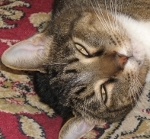EPR: just a comfort feature or affects AHI
EPR: just a comfort feature or affects AHI
Have you experimented with the EPR setting? Does it affect your AHI, or how well you slept, or your symptoms the next day? I'm wondering about the relation to EPR level and pressure setting...trying to find something to make sleep more refreshing.
- leonardlake
- Posts: 73
- Joined: Thu Feb 15, 2007 12:47 pm
- Location: Colorado
Re: EPR: just a comfort feature or affects AHI
Actually my S9 Autoset EPR causes my AHI to increase. I don't really notice any comfort difference on any EPR setting. So I just leave it off. I also found that even a small range of pressures (like from 8.6 to 9.4) caused my AHI to increase. So now I just leave my pressure at 9 cm H2O with EPR of 0 and my AHI is about 1.2.
_________________
| Humidifier: S9™ Series H5i™ Heated Humidifier with Climate Control |
| Additional Comments: Using ResScan V3.12 software to keep a tight pressure range around 9 cm H20 to minimize hyponeas and obstructive and central apneas |
Re: EPR: just a comfort feature or affects AHI
EPR and CFLEX are strictly comfort features. If you can tolerate CPAP with using them, your OSA will be treated more efficiently. Not huge amounts of difference, but still better.
Re: EPR: just a comfort feature or affects AHI
Experiment with your EPR and see how you feel. To my surprise, I discovered that my AHIs were lower and I felt better with my EPR set at 3--and that's pretty much contrary to what should have happened.
So keep track of what setting you have with what AHI and feeling the next morning; try each setting for a few nights, then decide what works best for YOU.
Weezy
So keep track of what setting you have with what AHI and feeling the next morning; try each setting for a few nights, then decide what works best for YOU.
Weezy
_________________
| Mask: Swift™ FX Nasal Pillow CPAP Mask with Headgear |
| Humidifier: S9™ Series H5i™ Heated Humidifier with Climate Control |
| Additional Comments: Hybrid is alternate mask |
Re: EPR: just a comfort feature or affects AHI
Its a comfort feature, and it can make a difference to some people's AHI - in either direction. You have to find out what it does for you.
_________________
| Mask: AirFit™ P10 Nasal Pillow CPAP Mask with Headgear |
| Additional Comments: Machine: Resmed AirSense10 for Her with Climateline heated hose ; alternating masks. |
And now here is my secret, a very simple secret; it is only with the heart that one can see rightly, what is essential is invisible to the eye.
Antoine de Saint-Exupery
Good advice is compromised by missing data
Forum member Dog Slobber Nov. 2023
Antoine de Saint-Exupery
Good advice is compromised by missing data
Forum member Dog Slobber Nov. 2023
Re: EPR: just a comfort feature or affects AHI
I was told by my clinician (has a B.S. degree in Cardiopulmonary Sciences) that since my CPAP pressure of around 8 cm H2O is not "hi" then I should stop using the EPR after I got used to the CPAP because CPAP's Pressure Relief - A-Flex, C-Flex, and EPR, etc., are causing instability in the ventilation system. Has anyone heard about it?
_________________
| Humidifier: S9™ Series H5i™ Heated Humidifier with Climate Control |
| Additional Comments: S9 Autoset machine; Ruby chinstrap under the mask straps; ResScan 5.6 |
see my recent set-up and Statistics:
http://i.imgur.com/TewT8G9.png
see my recent ResScan treatment results:
http://i.imgur.com/3oia0EY.png
http://i.imgur.com/QEjvlVY.png
http://i.imgur.com/TewT8G9.png
see my recent ResScan treatment results:
http://i.imgur.com/3oia0EY.png
http://i.imgur.com/QEjvlVY.png
Re: EPR: just a comfort feature or affects AHI
This is one place where the statistics feature of ResScan review data is very useful. Set your pressure and your epr and then leave it there for 5-6 days. Then make a change if you feel you want to, and do the same.It's always best to change 1 variable at atime. After a few trials like this you can use the statistics view to really see what effect the change is having on your numbers. I would recommend keeping daily notes on how you feel and at the end of a couple of weeks you should really have some helpful info. Be sure to down load the data from your card every few days and then when you want to look at the numbers you enter the date range for each setting and you'll be able to see a lot.
_________________
| Mask: Quattro™ FX Full Face CPAP Mask with Headgear |
| Humidifier: S9™ Series H5i™ Heated Humidifier with Climate Control |
Re: EPR: just a comfort feature or affects AHI
If it's difficult for you to sleep with the flow generator, EPR may lower your AHI because it will reduce arousals which would score as hypoapnea events. But because it can go below the minimum pressure you set, and, unlike aflex, it won't return to therapeutic pressure until you begin to inhale, your airway can collapse. Hence EPR could increase your AHI with more apnea events getting through, and your sleep could be disturbed when it automatically shuts off for several minutes to prevent apnea. Try either turning EPR off completely or adjusting your settings so that minimum (or constant) pressure - EPR = titrated pressure.
_________________
| Mask: Quattro™ FX Full Face CPAP Mask with Headgear |
| Humidifier: S9™ Series H5i™ Heated Humidifier with Climate Control |
| Additional Comments: Software: SleepyHead 0.9 beta |
Download Sleepyhead here: https://sourceforge.net/projects/sleepyhead/
Re: EPR: just a comfort feature or affects AHI
avi123 wrote:I was told by my clinician (has a B.S. degree in Cardiopulmonary Sciences) that since my CPAP pressure of around 8 cm H2O is not "hi" then I should stop using the EPR after I got used to the CPAP because CPAP's Pressure Relief - A-Flex, C-Flex, and EPR, etc., are causing instability in the ventilation system. Has anyone heard about it?
Bingo! Another downside to pressure relief is the certain amount of "lag" between the two pressures. Everyone knows that the obstruction occurs during the inspiratory side of the cycle, so if your needed pressure to keep the airway patent has dropped during expiration, although very small, there is still a time when you "need" the full pressure but machine is still not there yet.
I remember having this debate with two physicians back when CFLEX was introduced. One doctor was of the opinion that it should not be used because the patient would not ALWAYS be getting their optimal pressure. Me and the other doctor agreed that although this is true, the benefit of having more people compliant out weighed the pressure issue. Both docs, who are directors over multiple labs, titrating patients with pressure relief in all of their labs. Every now and then, I do see an Rx with a low pressure of 8 or lower with a comfort setting also prescribed. This is usually from an inexperienced technician.
Re: EPR: just a comfort feature or affects AHI
Recognizing that everyone is different, here is my experience.
I have been incrementally increasing my minimum pressure from 4 to 8. (8 being my Rx). I had turned off SmartFlex until last night and decided to set the EPR at 1. Intellipap offers 3 EPR settings of 1cm each and six settings each for inhalation/exhalation. Right now I have both I and E set at 0 whicih gives me an abrupt change so I didn't experience any "lag time".
I believe EPR is a good tool but I still need to learn more about using it. Last night was good for me. AHI was 2.2. Pressure reading was 8 to 8.4. I have had a high AHI of 7 and a low of .4. 2.2 seems about average for me, so I didn't see a negative effect from EPR last night. I intend to stay with these settings for a while to see what happens.
Larry
I have been incrementally increasing my minimum pressure from 4 to 8. (8 being my Rx). I had turned off SmartFlex until last night and decided to set the EPR at 1. Intellipap offers 3 EPR settings of 1cm each and six settings each for inhalation/exhalation. Right now I have both I and E set at 0 whicih gives me an abrupt change so I didn't experience any "lag time".
I believe EPR is a good tool but I still need to learn more about using it. Last night was good for me. AHI was 2.2. Pressure reading was 8 to 8.4. I have had a high AHI of 7 and a low of .4. 2.2 seems about average for me, so I didn't see a negative effect from EPR last night. I intend to stay with these settings for a while to see what happens.
Larry
_________________
| Mask: Swift™ FX Nasal Pillow CPAP Mask with Headgear |
| Additional Comments: SmartLink upgraded to version 2.5.6. Using CMS 50D+ Oximeter and Respironics SimplyGo POC |
Re: EPR: just a comfort feature or affects AHI
Well said. Perfect summary of the most important point. Thanks, ozij!ozij wrote:Its a comfort feature, and it can make a difference to some people's AHI - in either direction. You have to find out what it does for you.
Here is more wisdom for this thread, from a post made by Rested Gal that touched on a difference between two brands' pressure relief:
viewtopic.php?f=1&t=58773&p=555183#p555183
- Bright Choice
- Posts: 596
- Joined: Fri Jan 14, 2011 5:17 pm
Re: EPR: just a comfort feature or affects AHI
I have had a positive experience using EPR but I really don't understand it. My AHI is fine, I was trying to get desats undercontrol. My doc said to experiement with pressures to see if I could get the desats to drop. During the time period that desats were the worst, I would wake up feeling pretty "hungover" (no alcohol), spacey, tired etc. During the course of the pressure change experiment, I decided to try EPR. I set it to 2 and haven't had a desat since and wake up without the hangover.
Another interesting observation is that with the EPR on I noticed that the air coming into the mask (quattro fx ffm) was considerably cooler and fresher. Makes me think that I was getting asphyxiated but I have not a clue as to what this all means.
I do know that some docs are using pressure gradient differentials more - ie difference between ipap and epap. I have UARS & have been reading info from Dr. Krakow. I know that he uses bilevel a lot & it almost sounded like he is using it more than cpap. He says that the gradient differential he uses is most often more than 3 (which would be the max of EPR) but the EPR change would be similar to bipap.
Seems to me that EPR can be used for more than comfort.
Another interesting observation is that with the EPR on I noticed that the air coming into the mask (quattro fx ffm) was considerably cooler and fresher. Makes me think that I was getting asphyxiated but I have not a clue as to what this all means.
I do know that some docs are using pressure gradient differentials more - ie difference between ipap and epap. I have UARS & have been reading info from Dr. Krakow. I know that he uses bilevel a lot & it almost sounded like he is using it more than cpap. He says that the gradient differential he uses is most often more than 3 (which would be the max of EPR) but the EPR change would be similar to bipap.
Seems to me that EPR can be used for more than comfort.
_________________
| Mask: Mirage™ FX For Her Nasal CPAP Mask with Headgear |
| Humidifier: S9™ Series H5i™ Heated Humidifier with Climate Control |
| Additional Comments: S9 VPAP Adapt, CompSA, RLS/PLMD, Insomnia, started 12/30/10 Rescan 3.14 |
- Ms.Snuffleupagus
- Posts: 281
- Joined: Sun Nov 22, 2009 6:28 pm
- Location: Canada
Re: EPR: just a comfort feature or affects AHI
I only use EPR during settling mode. I switched to a FF mask due to exhalation puffs/ mouth leaks and after I got tired of chin straps and taping. I had always assumed that EPR should not be used as it would affect AHI. But I wonder if EPR could lessen mouth leaks because of increased comfort. This could mean the difference between using nasal or pillow masks rather than a FF mask. Has anyone had this happen to them?
Re: EPR: just a comfort feature or affects AHI
Because CFlex returns to baseline way before inhalation, that should not be an issue, and Respironics has some white papers to support its effectiveness (although there used to be a stutter at high pressures with the use of CFlex)(memo to self - see if that's still there).mcdover wrote:I remember having this debate with two physicians back when CFLEX was introduced. One doctor was of the opinion that it should not be used because the patient would not ALWAYS be getting their optimal pressure.
EPR on the other hand, carries out that relief much longer, and, "IMHO", be an issue in some patients.
Further, I have significant concerns about the use of EPR during FOT. Baseline pressure is dropped during FOT scouts, so in theory, a patient with central apneas, but some obstructive tendencies, may end up with misidentified events.
For a more technical observation of why this may be so see
viewtopic.php?f=1&t=61788&st=0&sk=t&sd=a&start=15
In the latter part that example, while the patient is on 8 cmH2O, the FOT scout occurs at 5 cmH2O. So what really happens is that the patient gets a pressure decrease challenge and then a central event search. I believe the end result is that the ResMed central identification algorithm is flawlessly specific but horrid in it's sensitivity:
Algorithm: I know you're on 8 cmH2O, but I think I'll go look for centrals at 5 cmH2O.
Patient: How 'bout them Lady Huskies!
"Don't Blame Me...You Took the Red Pill..."
Re: EPR: just a comfort feature or affects AHI
If "EPR" is ResMed's clever way of hiding bilevel in CPAP clothing, then in reality, aren't there two therapeutic pressures--one for IPAP and one for EPAP--when it is being used? My understanding is that although EPR is being called a comfort feature, it is actually a way of dropping treatment pressure during exhale and is thus a form of bilevel being used for comfort reasons. How far off am I?
Are you suggesting that ResMed should suspend EPR before any use of FOT?
To me it all gets back to the fact that the state of the airway is not so much the determining factor for whether an event should be considered central or not. Effort is different from state of airway, right? So shouldn't specificity and sensitivity be judged only on how well it does at determining the state of the airway and not the presence or absence of effort? And if so, isn't it more informative to learn the state of the airway during the lowest pressure rather than during the highest pressure?
Am I being particularly wrong and stupid, or just a little wrong and stupid?
(Go Big Blue!)
edit: I guess "absence" is spelled with a "c" isn't it? Yep, that makes sence.
Are you suggesting that ResMed should suspend EPR before any use of FOT?
To me it all gets back to the fact that the state of the airway is not so much the determining factor for whether an event should be considered central or not. Effort is different from state of airway, right? So shouldn't specificity and sensitivity be judged only on how well it does at determining the state of the airway and not the presence or absence of effort? And if so, isn't it more informative to learn the state of the airway during the lowest pressure rather than during the highest pressure?
Am I being particularly wrong and stupid, or just a little wrong and stupid?
(Go Big Blue!)
edit: I guess "absence" is spelled with a "c" isn't it? Yep, that makes sence.
Last edited by jnk on Thu Mar 31, 2011 6:16 am, edited 1 time in total.
















